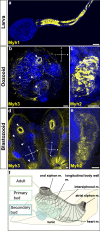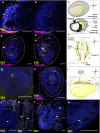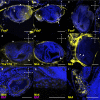Modular co-option of cardiopharyngeal genes during non-embryonic myogenesis
- PMID: 30867897
- PMCID: PMC6399929
- DOI: 10.1186/s13227-019-0116-7
Modular co-option of cardiopharyngeal genes during non-embryonic myogenesis
Abstract
Background: In chordates, cardiac and body muscles arise from different embryonic origins. In addition, myogenesis can be triggered in adult organisms, during asexual development or regeneration. In non-vertebrate chordates like ascidians, muscles originate from embryonic precursors regulated by a conserved set of genes that orchestrate cell behavior and dynamics during development. In colonial ascidians, besides embryogenesis and metamorphosis, an adult can propagate asexually via blastogenesis, skipping embryo and larval stages, and form anew the adult body, including the complete body musculature.
Results: To investigate the cellular origin and mechanisms that trigger non-embryonic myogenesis, we followed the expression of ascidian myogenic genes during Botryllus schlosseri blastogenesis and reconstructed the dynamics of muscle precursors. Based on the expression dynamics of Tbx1/10, Ebf, Mrf, Myh3 for body wall and of FoxF, Tbx1/10, Nk4, Myh2 for heart development, we show that the embryonic factors regulating myogenesis are only partially co-opted in blastogenesis, and that markers for muscle precursors are expressed in two separate domains: the dorsal tube and the ventral mesenchyma.
Conclusions: Regardless of the developmental pathway, non-embryonic myogenesis shares a similar molecular and anatomical setup as embryonic myogenesis, but implements a co-option and loss of molecular modules. We then propose that the cellular precursors contributing to heart and body muscles may have different origins and may be coordinated by different developmental pathways.
Keywords: Ascidians; Blastogenesis; Botryllus schlosseri; Budding; Muscle; Regeneration.
Figures





Similar articles
-
De novo neurogenesis in a budding chordate: Co-option of larval anteroposterior patterning genes in a transitory neurogenic organ.Dev Biol. 2019 Apr 15;448(2):342-352. doi: 10.1016/j.ydbio.2018.10.009. Epub 2018 Oct 25. Dev Biol. 2019. PMID: 30563648
-
Common and divergent pathways in alternative developmental processes of ascidians.Bioessays. 2006 Sep;28(9):902-12. doi: 10.1002/bies.20462. Bioessays. 2006. PMID: 16937358 Review.
-
Wnt affects symmetry and morphogenesis during post-embryonic development in colonial chordates.Evodevo. 2015 May 1;6:17. doi: 10.1186/s13227-015-0009-3. eCollection 2015. Evodevo. 2015. PMID: 26171140 Free PMC article.
-
Development of the neuromuscular system during asexual propagation in an invertebrate chordate.Dev Dyn. 2009 Aug;238(8):2081-94. doi: 10.1002/dvdy.22023. Dev Dyn. 2009. PMID: 19618474
-
Regulation and evolution of cardiopharyngeal cell identity and behavior: insights from simple chordates.Curr Opin Genet Dev. 2015 Jun;32:119-28. doi: 10.1016/j.gde.2015.02.008. Epub 2015 Mar 25. Curr Opin Genet Dev. 2015. PMID: 25819888 Free PMC article. Review.
Cited by
-
Spatially and Temporally Distributed Complexity-A Refreshed Framework for the Study of GRN Evolution.Cells. 2022 May 30;11(11):1790. doi: 10.3390/cells11111790. Cells. 2022. PMID: 35681485 Free PMC article.
-
Nematostella vectensis, an Emerging Model for Deciphering the Molecular and Cellular Mechanisms Underlying Whole-Body Regeneration.Cells. 2021 Oct 8;10(10):2692. doi: 10.3390/cells10102692. Cells. 2021. PMID: 34685672 Free PMC article. Review.
-
The Diversity of Muscles and Their Regenerative Potential across Animals.Cells. 2020 Aug 19;9(9):1925. doi: 10.3390/cells9091925. Cells. 2020. PMID: 32825163 Free PMC article. Review.
-
Comparing dormancy in two distantly related tunicates reveals morphological, molecular, and ecological convergences and repeated co-option.Sci Rep. 2022 Jul 23;12(1):12620. doi: 10.1038/s41598-022-16656-8. Sci Rep. 2022. PMID: 35871255 Free PMC article.
-
Regulation and evolution of muscle development in tunicates.Evodevo. 2019 Jun 24;10:13. doi: 10.1186/s13227-019-0125-6. eCollection 2019. Evodevo. 2019. PMID: 31249657 Free PMC article. Review.
References
LinkOut - more resources
Full Text Sources
Miscellaneous

